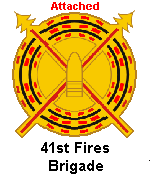
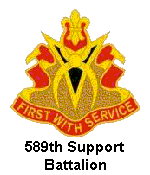
589th Brigade Support Battalion
Organizational Legacy
"First With Service"


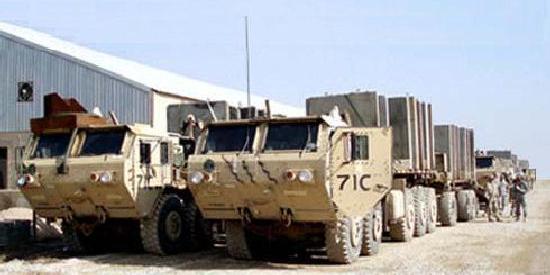 |
|---|
| "M1075 PLS Trucks Delivering Concrete Barriers - Apr 2006" |
|---|

Battalion Distinctive Unit Insignia
 Introduction
Introduction


 The 1st Cavalry Division, a major subordinate command of the US Third Mobile
Armored Corps, is a 19,000 soldier, heavy armored division stationed at Ft.
Hood, TX. As one of the two "on-call" heavy contingency force divisions of the
Army, the First Team has an on-order mission to deploy by sea, air or land to
any part of the world on a short notice. The following narratives, divided in
timeline eras of major operational missions, describes the threat environment,
tactical conditions, evolution of equipment technology and the strategic
methodology employed by one of its command units, the 41st Fires Brigade and
its Subordinate Units, to contribute to the successful missions enhancement of
the warring organization of the 1st Cavalry Division and the honors they
achieved are summarized in the chapters that follow.
The 1st Cavalry Division, a major subordinate command of the US Third Mobile
Armored Corps, is a 19,000 soldier, heavy armored division stationed at Ft.
Hood, TX. As one of the two "on-call" heavy contingency force divisions of the
Army, the First Team has an on-order mission to deploy by sea, air or land to
any part of the world on a short notice. The following narratives, divided in
timeline eras of major operational missions, describes the threat environment,
tactical conditions, evolution of equipment technology and the strategic
methodology employed by one of its command units, the 41st Fires Brigade and
its Subordinate Units, to contribute to the successful missions enhancement of
the warring organization of the 1st Cavalry Division and the honors they
achieved are summarized in the chapters that follow.
Mission:
 The mission of the 589th Brigade Support Battalion, "Iron Caissons", is to
provide logistical support to 41st Fires Brigade, 1st Cavalry Division.
The 589th Brigade Support Battalion is organized with a Headquarters and
Headquarters Company, and two Support Companies, "Alpha" and "Bravo".
The mission of the 589th Brigade Support Battalion, "Iron Caissons", is to
provide logistical support to 41st Fires Brigade, 1st Cavalry Division.
The 589th Brigade Support Battalion is organized with a Headquarters and
Headquarters Company, and two Support Companies, "Alpha" and "Bravo".
Organizational Summary:
The Fires Brigade plans, prepares, executes, and assesses operations to
provide close support, shaping, and decisive fires for the Division. The Fires
Bigade is the primary executor of Army and Joint fires in areas not assigned
to Brigade Combat Teams. It is capable of employing Army and Joint air surface
and aerially delivered fires as well as incorporating Special Operations
Forces (SOF), Information Operations (IO), Civil Affairs (CA), and Army
Airspace Command and Control (A2C2) elements. The Fires Brigade gives the
Division/corps commander a headquarters to plan, synchronize, and execute
strike, counterstrike, and reinforcing fires across the division.
 The Fires Brigade also has the necessary command and control structure to
integrate attached ground and air maneuver forces and function as a maneuver
headquarters for limited operations. Fires Brigades are characterized by
networked intelligence, robust communications, and systems that facilitate the
efficient application of fires. The fires brigade is capable of being a
supported or supporting unit and providing and coordinating Joint lethal and
non-lethal fires including Information Operations (IO). Fires Brigades also
have the necessary fires support and targeting structure to effectively
execute the entire decide, detect, deliver, and assess (D3A) process.
The Fires Brigade also has the necessary command and control structure to
integrate attached ground and air maneuver forces and function as a maneuver
headquarters for limited operations. Fires Brigades are characterized by
networked intelligence, robust communications, and systems that facilitate the
efficient application of fires. The fires brigade is capable of being a
supported or supporting unit and providing and coordinating Joint lethal and
non-lethal fires including Information Operations (IO). Fires Brigades also
have the necessary fires support and targeting structure to effectively
execute the entire decide, detect, deliver, and assess (D3A) process.
Logistics Support to Modular Force Brigades
 The Brigade Support Battakions (BSBs) provides support to the Fires Brigade by
providing and/or coordinating supplies and support, field maintenance and
transportation support along with a mix of capabilities that can be organized
for any combination of offensive, defensive, stability operations, or civil
support operations.
The Brigade Support Battakions (BSBs) provides support to the Fires Brigade by
providing and/or coordinating supplies and support, field maintenance and
transportation support along with a mix of capabilities that can be organized
for any combination of offensive, defensive, stability operations, or civil
support operations.
Concept of Support
 The Brigade Support Battalion plans, coordinates, synchronizes, and executes
replenishment operations in support of brigade operations. It distributes
supply, food service and Army Health System (AHS), as well as field
maintenance and limited recovery. It maintains visibility of the theater
distribution system, synchronizing the flow of throughput into the operational
area of the Brigade.
The Brigade Support Battalion plans, coordinates, synchronizes, and executes
replenishment operations in support of brigade operations. It distributes
supply, food service and Army Health System (AHS), as well as field
maintenance and limited recovery. It maintains visibility of the theater
distribution system, synchronizing the flow of throughput into the operational
area of the Brigade.
 BSBs provide a materiel carrying capability that enables the brigades to
conduct sustained operations for a finite period of time. BSBs typically plan
and execute replenishment operations in support of maneuver force battles and
engagements. They are deliberate, time-sensitive operations conducted to
replenish forward support companies with essential supplies to sustain the
operations tempo. When required, a supporting sustainment brigade may augment
BSB capabilities during BSB-planned and executed replenishment operations.
BSBs provide a materiel carrying capability that enables the brigades to
conduct sustained operations for a finite period of time. BSBs typically plan
and execute replenishment operations in support of maneuver force battles and
engagements. They are deliberate, time-sensitive operations conducted to
replenish forward support companies with essential supplies to sustain the
operations tempo. When required, a supporting sustainment brigade may augment
BSB capabilities during BSB-planned and executed replenishment operations.
Synchronization of Battle Rhythm and Logistics Operations
 Support operations are fully integrated with the brigade battle rhythm through
planning and oversight of on-going operations. Logistics and operational
planning occurs simultaneously rather than sequentially. Incremental
adjustments to either the maneuver or logistics plan during its execution must
be visible to all Fire Brigade elements. The logistics synchronization matrix
and logistics reports are both used to initiate and maintain synchronization
between operations and logistics functions.
Support operations are fully integrated with the brigade battle rhythm through
planning and oversight of on-going operations. Logistics and operational
planning occurs simultaneously rather than sequentially. Incremental
adjustments to either the maneuver or logistics plan during its execution must
be visible to all Fire Brigade elements. The logistics synchronization matrix
and logistics reports are both used to initiate and maintain synchronization
between operations and logistics functions.
Supply Point Distribution
 Supply point distribution requires unit representatives to move to a supply
point to pick up their supplies. Supply point distribution is most commonly
executed by means of a Logistics Release Point (LRP). The LRP may be any place
on the ground where unit vehicles return to pick up supplies and then take
them forward to their unit. Occasionally, the LRP is the brigade support area
(BSA) itself.
Supply point distribution requires unit representatives to move to a supply
point to pick up their supplies. Supply point distribution is most commonly
executed by means of a Logistics Release Point (LRP). The LRP may be any place
on the ground where unit vehicles return to pick up supplies and then take
them forward to their unit. Occasionally, the LRP is the brigade support area
(BSA) itself.
Refuel On The Move
 The Refuel On the Move (ROM) method is conducted by having a fixed time and
place to conduct the refuel operations Concurrent with unit battle rhythm. As
a general rule, a ROM operation is established and conducted as part of a
unit movement. A ROM may be built to support several types of units passing
through a point sequentially.
The Refuel On the Move (ROM) method is conducted by having a fixed time and
place to conduct the refuel operations Concurrent with unit battle rhythm. As
a general rule, a ROM operation is established and conducted as part of a
unit movement. A ROM may be built to support several types of units passing
through a point sequentially.
Summary
 The Modular Force has allowed Army units to become more responsive and
lexible as Army commanders required. The needs of the Commander can be met
with greater efficiency, and decreased response times. There will no longer be
a need to disassemble large unitized structures to create specialized task
forces that leave behind valuable manpower. The Modular Force Brigades are
part of the transforming Army which provides commanders with ready and
relevant warfighting capabilities that are mission-tailored and scalable. BSBs
provide a mix of capabilities that can be organized for any combination of
support operations.
The Modular Force has allowed Army units to become more responsive and
lexible as Army commanders required. The needs of the Commander can be met
with greater efficiency, and decreased response times. There will no longer be
a need to disassemble large unitized structures to create specialized task
forces that leave behind valuable manpower. The Modular Force Brigades are
part of the transforming Army which provides commanders with ready and
relevant warfighting capabilities that are mission-tailored and scalable. BSBs
provide a mix of capabilities that can be organized for any combination of
support operations.
Formation of the 589th Brigade Support Battalion
 On 29 July 1944, the 589th Brigade Support Battalion, "Iron Caissons," was
constituted in the Army of the United States as Headquarters and Headquarters
Detachment, 589th Quartermaster Battalion, Mobile, and activated in England.
It served in three campaigns during the Second World War: Rhineland,
Ardennes-Alsace, and Central Europe.
On 29 July 1944, the 589th Brigade Support Battalion, "Iron Caissons," was
constituted in the Army of the United States as Headquarters and Headquarters
Detachment, 589th Quartermaster Battalion, Mobile, and activated in England.
It served in three campaigns during the Second World War: Rhineland,
Ardennes-Alsace, and Central Europe.
 On 1 August 1946, the unit was converted and redesignated as Headquarters and
Headquarters Detachment, 589th Transportation Corps Truck Battalion. On 01
February 1947, the unit was converted and redesignated as Headquarters and
Headquarters Detachment, 589th Quartermaster Battalion. It was inactivated on
20 June 1948 in France.
On 1 August 1946, the unit was converted and redesignated as Headquarters and
Headquarters Detachment, 589th Transportation Corps Truck Battalion. On 01
February 1947, the unit was converted and redesignated as Headquarters and
Headquarters Detachment, 589th Quartermaster Battalion. It was inactivated on
20 June 1948 in France.
To Be continued ...............

 Functions performed by the subordinate elements of the Battalion are:
Functions performed by the subordinate elements of the Battalion are:
| UNIT | SERVICE SPECIALITY |
|---|
| HHC | Headquarters & Headquarters Company |
|---|
| "A" Company | |
|---|
| "B" Company | |
|---|

 This folio of material highlights of the many subsequent historical critical
missions performed by members of the 115th Brigade Support Battalion, whose
actions, operations and the many critical issues resolved over its 92+ years
history to meet the changing threat and the honors they achieved are
summarized in the following sections:
This folio of material highlights of the many subsequent historical critical
missions performed by members of the 115th Brigade Support Battalion, whose
actions, operations and the many critical issues resolved over its 92+ years
history to meet the changing threat and the honors they achieved are
summarized in the following sections:
 Table of Contents
Table of Contents
















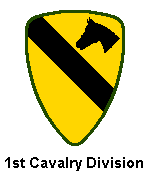



 If none of the data that you have found by surfing the reference unit chapter
titles and indexes measures up to your interests, you may want to deploy the
R&S (Reconnaissance and Surveillance) Scouts to search and identify keywords
or subjects within individual unit pages. Enter the descriptive keyword or
search terms(s) in the input field and "Click" on the Search button to screen the multiple DataBases of
the Cavalry OutPost and the garrisoned occupants - "The 1st Cavalry Division
and its Subordinate Units".
If none of the data that you have found by surfing the reference unit chapter
titles and indexes measures up to your interests, you may want to deploy the
R&S (Reconnaissance and Surveillance) Scouts to search and identify keywords
or subjects within individual unit pages. Enter the descriptive keyword or
search terms(s) in the input field and "Click" on the Search button to screen the multiple DataBases of
the Cavalry OutPost and the garrisoned occupants - "The 1st Cavalry Division
and its Subordinate Units".
 The search action will open the "first-team.us WebSite - R&S Scout Report",
which displays a listing of WebSite Titles and HTML Summaries that contain the
specific search term(s) of interest. To review any that best depicts a match
of your search term(s), "Click" on the WebSite Title to open a New Window.
After the WebSite is fully loaded, use the browser [EDIT/Find] Tool Button to
locate the search term within the page. After reviewing, close the New Window
to return to the listing of WebSites.
The search action will open the "first-team.us WebSite - R&S Scout Report",
which displays a listing of WebSite Titles and HTML Summaries that contain the
specific search term(s) of interest. To review any that best depicts a match
of your search term(s), "Click" on the WebSite Title to open a New Window.
After the WebSite is fully loaded, use the browser [EDIT/Find] Tool Button to
locate the search term within the page. After reviewing, close the New Window
to return to the listing of WebSites.
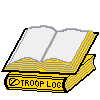



 If this is your first review of the Outpost of the 1st Cavalry Division and
its Subordinate Units, you may want to record your own report on your findings
during your visit, or perhaps you may want to review the log entries of other
visitors.
If this is your first review of the Outpost of the 1st Cavalry Division and
its Subordinate Units, you may want to record your own report on your findings
during your visit, or perhaps you may want to review the log entries of other
visitors.

To report on your findings,
"click" on the "Report-In"
Index Tab of the Troop Log. |
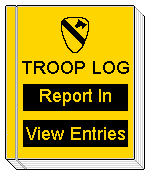
|

To review entries of others,
"Click"on the "View Entries"
Index Tab of the Troop Log. |
|---|

 As you journey through the history of the 1st Cavalry Division and its
assigned elements, you may find it interesting enough to send a message to
your friends and extend them an invitation for the opportunity to review the
rich history of the Division. We have made it easy for you to do. All that is
required is for you to click on the Push Button below, fill in their eMail
addresses and send.
As you journey through the history of the 1st Cavalry Division and its
assigned elements, you may find it interesting enough to send a message to
your friends and extend them an invitation for the opportunity to review the
rich history of the Division. We have made it easy for you to do. All that is
required is for you to click on the Push Button below, fill in their eMail
addresses and send.


|
The TITLE and URL of this WebSite are automatically read, formatted
and entered into your standard eMail form. |
|
|
Note - The eMail Message is processed and transmitted On-Line to the
addressee(s) via your Internet Provider.
Copyright © 2002, Cavalry Outpost Publications ® |




 eMail Your WebSite Comments.
eMail Your WebSite Comments.


 Return to "MyOwnPages"©.
Return to "MyOwnPages"©.

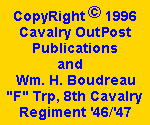 Copyright © 1996, Cavalry Outpost Publications ® and
Trooper Wm. H. Boudreau, "F" Troop, 8th Cavalry Regiment (1946 - 1947). All
rights to this body of work are reserved and are not in the public domain, or
as noted in the bibliography. Reproduction, or transfer by electronic means,
of the History of the 1st Cavalry Division, the subordinate units or any
internal element, is not permitted without prior authorization. Readers are
encouraged to link to any of the pages of this Web site, provided that proper
acknowledgment attributing to the source of the data is made. The information
or content of the material contained herein is subject to change without
notice.
Copyright © 1996, Cavalry Outpost Publications ® and
Trooper Wm. H. Boudreau, "F" Troop, 8th Cavalry Regiment (1946 - 1947). All
rights to this body of work are reserved and are not in the public domain, or
as noted in the bibliography. Reproduction, or transfer by electronic means,
of the History of the 1st Cavalry Division, the subordinate units or any
internal element, is not permitted without prior authorization. Readers are
encouraged to link to any of the pages of this Web site, provided that proper
acknowledgment attributing to the source of the data is made. The information
or content of the material contained herein is subject to change without
notice.
Revised 03 Apr '12 SpellChecked






 Introduction
Introduction















 Copyright © 1996, Cavalry Outpost Publications ® and
Trooper Wm. H. Boudreau, "F" Troop, 8th Cavalry Regiment (1946 - 1947). All
rights to this body of work are reserved and are not in the public domain, or
as noted in the bibliography. Reproduction, or transfer by electronic means,
of the History of the 1st Cavalry Division, the subordinate units or any
internal element, is not permitted without prior authorization. Readers are
encouraged to link to any of the pages of this Web site, provided that proper
acknowledgment attributing to the source of the data is made. The information
or content of the material contained herein is subject to change without
notice.
Copyright © 1996, Cavalry Outpost Publications ® and
Trooper Wm. H. Boudreau, "F" Troop, 8th Cavalry Regiment (1946 - 1947). All
rights to this body of work are reserved and are not in the public domain, or
as noted in the bibliography. Reproduction, or transfer by electronic means,
of the History of the 1st Cavalry Division, the subordinate units or any
internal element, is not permitted without prior authorization. Readers are
encouraged to link to any of the pages of this Web site, provided that proper
acknowledgment attributing to the source of the data is made. The information
or content of the material contained herein is subject to change without
notice.